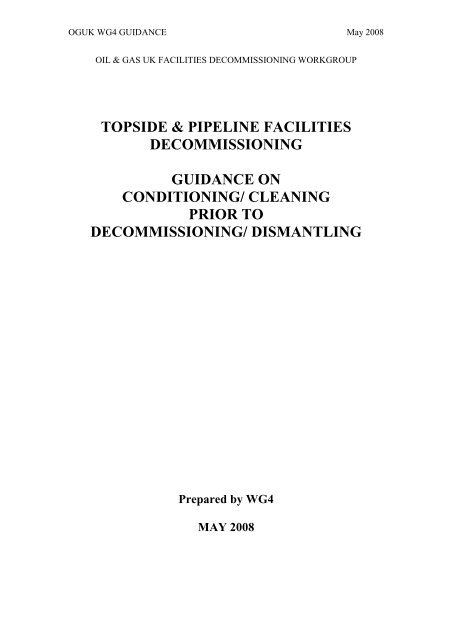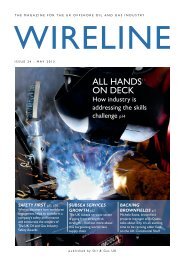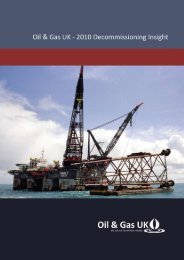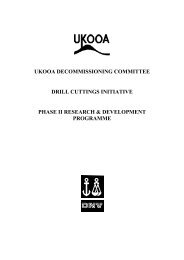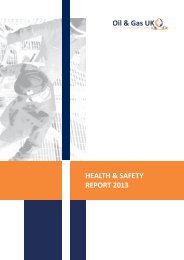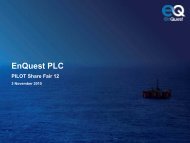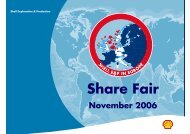topside & pipeline facilities decommissioning ... - Oil & Gas UK
topside & pipeline facilities decommissioning ... - Oil & Gas UK
topside & pipeline facilities decommissioning ... - Oil & Gas UK
Create successful ePaper yourself
Turn your PDF publications into a flip-book with our unique Google optimized e-Paper software.
OG<strong>UK</strong> WG4 GUIDANCE May 2008OIL & GAS <strong>UK</strong> FACILITIES DECOMMISSIONING WORKGROUPTOPSIDE & PIPELINE FACILITIESDECOMMISSIONINGGUIDANCE ONCONDITIONING/ CLEANINGPRIOR TODECOMMISSIONING/ DISMANTLINGPrepared by WG4MAY 2008
OG<strong>UK</strong> WG4 GUIDANCE May 2008INDEXIntroductionOverviewFlow Charts1. Contract Strategy Decision2. Inventory Checking3. Resale / Reuse Decision4. Define Cleanliness Standard5. Topsides Cleaning Issues6. Onshore Dismantle / Disposal7. Pipeline Cleaning8. Topsides Cleaning Techniques9. Safety Management System10.Safety Case Adjustments11.Workforce ManagementAppendicesDecommissioning Technology Forum (DTF) ReportExtract (Jul-06) Session 1Offshore Workshop Notes/ Participants (Oct-07) Session 2Onshore Workshop Notes/ Participants (Jan-08) Session 3Npf Break Out session Notes Session 4Pipeline Workshop Notes (Feb-08) Session 5
OG<strong>UK</strong> WG4 GUIDANCE May 2008IntroductionPart of OG<strong>UK</strong>/PILOT <strong>decommissioning</strong> initiative is to actively raise awareness about<strong>decommissioning</strong> issues; improve supply chain engagement and capture learning andexperience where available as part of continuous improvement agenda.This document is the first in what is hopefully a series offering guidance based onrecent experience from operators, consultants and contractors on <strong>topside</strong> and <strong>pipeline</strong>conditioning or cleaning as part of the <strong>decommissioning</strong> process. This area wasselected as several major projects have completed this activity phase.It builds on an earlier document prepared by the Decommissioning TechnologyForum based on Ekofisk; Frigg and NW Hutton experience.The input was gathered by five workshop sessions as below:1. DTF – Topsides Cleaning Workshop 9 May 20062. WG4 Workshop – Offshore Topside Cleaning 4 Oct 20073. WG4 Workshop – Onshore Topside Cleaning 31 Jan 20084. NPF Conference Topside Cleaning break out session 12 Feb 20085. WG4 Pipeline Cleaning Workshop 27 Feb 2008More details on participants and detail output are contained in the appendices.The document is intended to provide guidance on some of the issues faced, options tobe considered and opportunities for improvement that could be realised. It is notintended as a prescriptive series of requirements or a comprehensive guideline on howto execute the activities.To make the output accessible, usable and understandable the various areas coveredhave been discretely identified in the form of simple flowcharts. These charts are notexhaustive or necessarily complete but are intended to provide a rational flow in thepreparation process to stimulate early thought and minimise late surprises.It is hoped that the document provides a base to expand on as further experiencematerialises but any project will need to consider their own circumstances as differentexecution options maybe dictated by the overarching Project Execution Strategyrather than optimisation of a single activity.
Offshore <strong>Oil</strong> & <strong>Gas</strong> FacilitiesDecommissioningTOPSIDE & PIPELINE FACILITIESDECOMMISSIONING2INVENTORYCHECKING3RESALEREUSEDECISION1CONTRACTSTRATEGYDECISION5TOPSIDESCLEANINGISSUES6ONSHOREDISMANTLE/DISPOSAL4DEFINECLEANLINESSSTANDARD9SAFETYMANAGEMENTSYSTEM10SAFETYCASEADJUSTMENTS11WORKFORCEMANAGEMENT7PIPELINECLEANING8TOPSIDECLEANINGTECHNIQUESNotesThe above tries to simplistically represent how each of the detailed flowcharts are generallyrelated and also highlights the key overlaps, however, in practice many other interlinks exist.Each of the Detailed Flowcharts have identified which workshop sessions contributed to thatSpecific area of the process, as indicated by workshop sessions numbers on previous page.Session details and contributors can been found in Appendices.
HOW WILL RISK OF QUANTITYUNCERTAINTY BE HANDLED- IN THE CONTRACT?- BY THE REGULATOR?Offshore <strong>Oil</strong> & <strong>Gas</strong> Facilities DecommissioningCONTRACT STRATEGY DECISION1BLOCKERSOFFSHORE MANHOURSLARGE No OFFSHORE LIFTSDOUBLE HANDLINGDECK ACCESS / INTEGRITY &STORAGE SPACEWORKFORCEACCOMMODATIONWHAT IS OVERALL REMOVALSTRATEGY?DO WE LIMIT REMOVAL OPTIONSOR LEAVE OPEN?BLOCKERSOPERATOR ‘RELUCTANCE’UNPROVEN TECHNOLOGYLIMITED OFFLOADING SITESUNPROVEN COSTWorkshop Session – 2 3 4REDUCED OPPORTUNITY REUSEMAXIMUM OPPORTUNITY REUSEPIECE SMALLREVERSEMODULARSINGLE LIFTGREATER LEVEL OF OFFSHORE CLEANINGGREATER LEVEL OF ONSHORE CLEANINGWHY AND WHERE ARE WECLEANING / CONDITIONINGWEIGHTUNCERTAINTYHSE FOR PERSONNEL/ENV RISKIDENTIFYCONTAMINENTS &MINIMISE HAZARDSALLOWHOT CUTTINGREMOVE H-CSOURCES IMPACT ONHAZARD AND SAFETYCASEOPPORTUNITYTHE STANDARDS FOR SHUTDOWNS & TURNAROUNDS MAYBE EXCESSIVE FOR OFFSHORE PREPARATION – NOTSEEKING FLOW ASSURANCE, EQUIPMENT RELIABILITY &PERFORMANCE, INSPECTIONS REQUIREMENTSOPPORTUNITYNEED TO MAINTAIN PERSONNEL CONTINUITY BUT NEEDTRAINING IN CHANGING MINDSET OF OPERATIONS TODECOMMISSIONINGOPPORTUNITYJUST IDENTIFYING THAT CONTAMINANT IS PRESENT MAY BESUFFICIENT. UNLIKELY THAT QUANTITIES WILL BEPREDICTED WITH GREATER ACCURACY OR CLEANEDWITHOUT LEAVING TRACESOPPORTUNITYSUPPLY CHAIN CONSOLIDATION IF OFFSHORE / ONSHORECLEANING / CONDITIONING IS A SINGLE SUPPLIER. THESELECTION OF EFFICIENCY OF LOCATION WOULD BE MORESTRAIGHTFORWARDOPPORTUNITYMINIMISE REQUIREMENTS FOR ACCESS – CAN BE BIGGESTOFFSHORE MANPOWER REQUIREMENTOPPORTUNITYIS FLUSH SUFFICIENT? WHERE IS IT OK.OPPORTUNITYGREATER CO-OPERATION & DOCUMENT INTERFACEBETWEEN OFFSHORE & ONSHORE EARLY IN THE PROCESSKeyGreen – OpportunitiesPink – Observation / Consideration(Based on Current Experience)
Do you have anAccurate AssetRegister ?NoYesDo you knowWhat chemicals areonboardNoExecute aChemicalsInventory StudyOffshore <strong>Oil</strong> & <strong>Gas</strong> Facilities DecommissioningINVENTORY CHECKING2Develop an up todate RegisterYesWorkshop Sessions – 1 2 3Check that currentassumptions arevalidYesDo you know whatother constituents ofequipment may causeproblems ?NoExecute a detailedInventory StudyDo youKnow if there isLSA Scale in thewellbores ?YesCan it be re-injecteddown the wells?Or left in the wellNone PresentNoNone PresentIs there LSAin the productionpipework ?Not SureExecute a radiologicalcontamination SurveyCheck that currentassumptions are validYesNone PresentCheck that currentassumptions are validIs there LSAin the Productionseparation Systems?Not SureYesNaturally OccurringUraniumcontamination hasbeen found in someWI pipeworkExecute a radiologicalcontamination SurveyInfoUpdate Surveysas required or asaccess improvesNone PresentIs there Uraniumin the WI pipeworksystems ?Not SureExecute a Uraniumcontamination SurveyConsolidatedInventory ReportMay be missed as notusually checked for - checkassumptionsNone PresentIs thereradiologicalcontamination of the gashandling pipework?YesNaturally OccurringRadon is produced whichdegrades via Polonium toLead 210Not SureInfoExecute a radiologicalcontamination SurveyDevelop Waste Management PlanCleaning Strategy basedon inventories expectedMay be missed asPollonium not usuallychecked for - checkassumptionsYesMercury may leech intorust scale / metal ofpipeworkInfoNone PresentIs there Mercuryin the producedgas pipeworksystems ?Not SureExecute a mercurycontamination SurveyOPPORTUNITYUSE OPERATIONS EXPERIENCE & SHUTDOWNRECORDSMay be missed as Mercurynot usually checked for -check assumptionsYesBe aware that experience hasshown that a lack of a thresholdlimit when asbestos monitoringcan cause serious disruption toplans ie you currently eitherhave asbestos or notTake care wrt type of surveyand timing as destructivesurvey & finding asbestos cancause major problemsOPPORTUNITYDEVELOP IMPROVED NON INTRUSIVE MAPPINGTECHNIQUESInfoYesIs there asbestoson the platform ?Not SureExecute an AsbestosSurveyCheck that currentassumptions are validHot cutting of paint coatingscan introduce serioushealth hazards(isocyenates)- Effectively monitor Fumes& use latest PPEInfoCheck that currentassumptions are validYesDo you know whatpaint types havebeen used on theplatform ?Not SureExecute a PaintType SurveyKeyGreen – OpportunitiesPink – Observation / Consideration(Based on Current Experience)
Agree High Level Scopeeg. Level of Cleanliness- Re-Use or Not- Mothball / NUI or Not- LQ Available or NotInfoReactivating LQ & keyequipment after a longperiod of being Shutdowncan be time consumingand expensiveOffshore <strong>Oil</strong> & <strong>Gas</strong> Facilities DecommissioningRESALE / REUSE DECISION3Workshop Session – 1Can Firm dates forsupply of items for sale to‘Beach’ be givenNoReconsider ResaleStrategyNoYesNoInternal ResourcesDoesDecommissioningStrategy Involve NUIOperationsYesIs it intended toremove items early from<strong>facilities</strong> for SaleYesDecide How toMarket GoodsEvaluate cost of ItemRetrieval and Marketingvs Perceived value ofItem for SaleNoExternal ContractorsIs(Cost x Effort)
Frigg Criteria -Hydrocarbon10% = CleanOffshore <strong>Oil</strong> & <strong>Gas</strong> Facilities DecommissioningDEFINE CLEANLINESS STANDARD4InfoEstablish Material Inventory(As Early as Possible)Maximise use of RoutineOperations & ShutdownsDefine Cleanliness levelsfor systemsReview Hazards that mayremain after cleaningReview Potential for‘Recharge’ of Hazardsafter cleaning.Consider ‘Unexpected’HazardsYesHas an RPS Survey beenperformedInfoLSA / NORM – Considerimpacts of bringingashore – limited handling/disposal capacity is oftenan issue.Workshop Sessions – 1 2 3 4 5Establish Early Dialogue withregulator(s) on interpretation,precision requiredand disposal routes.Has a mercury survey beenperformed?InfoMercury can ‘sweat’ out ofscale/vessel walls andpiping if present.Is there a history of H2Scontaminated gas?InfoH2S can causephyrophorric scales toform which spontaneouslycombust if left to dry out.Is wax expected to remainafter flushing?InfoWax may have to beremoved if signifficant ormay be allowed todegradeNoIs a high flushing efficiencyrequired?InfoSteaming partial system /sub-systems has provednot to remove allcondensate from pipingsystems.COLD / NUI PHASEYesCONSIDERLEAVING EQUIPMENT / VESSELS OPEN TOVENT SO AVOIDING FUME BUILD-UP FROMREMNANTSConsider quantities foundand validity of strategyBLANKING OFF LSA CONTAMINATED SYSTEMSNO PRESERVATION OF EQUIPMENT / VESSELSAT ALLEg. AS PER EKOFISK / FRIGGA ‘RESIDUAL WASTE’ SURVEY PERFORMEDPOST CLEANING IS OFTEN NEEDED TOCONFIRM AMOUNTS OF ’WASTE’ BEINGRETURNED TO SHORE FOR DISPOSAL (NOSURPRISES)Develop appropriateDraining / Venting / ColdPhase StrategyBE AWARERESIDUAL WASTE SURVEYS HAVE IDENTIFIEDMATERIALS SUCH AS.Select appropriateCleaning technologiesOPPORTUNITYINTERROGATE SHIP CLEANING EXPERTISERESIDUAL HYDROCARBONSSLUDGESLSARESIDUAL CHEMICALSMERCURYASBESTOSPCB’sWAXES RECHARGING UNFLOODEDSYSTEMS. - CONSIDER MONITORING ORINERT GAS IF PRESENTKeyGreen – OpportunitiesPink – Observation / Consideration(Based on Current Experience)
i.e. When is the work to becarried out in relation toCessation of ProductionOffshore <strong>Oil</strong> & <strong>Gas</strong> Facilities DecommissioningTopsides Cleaning Issues5Workshop Session – 1Is there aDecommissioningStrategyYesCONSIDERDEVELOPING / AGREEING CLEANLINESS ANDPRESSURE HANDOVER CERTIFICATEREQUIREMENTS WITH OPERATIONS,WHAT HAPPENS TO OPERATIONAL CONSENTS INNUI MODE, LENGTH OF TIME PLATFORM WILL BECOLD – i.e. MAINTENANCE OF F&G SYSTEMS,SCE ELEMENTS, ACCOMMODATION.NoDevelop aDecommissioningPhasing StrategyEND FLUID / SOLID DISPOSAL PLANS – WHICHMAY DICTATE SYSTEM CLEANING SEQUENCESAND OFFSHORE CLEANING PERMITS. OPTIMISEUSE OF ‘OPERATIONAL DISCHARGE CONSENTS.AVOID DECOMMISSIONING SIMOPS WITH WELLSTO FINISH, BEFORE CLEANING UP TOPSIDES.THIS AVOIDS THE REQUIREMENT FOR SUB-SYSTEM ISOLATION CLEANING THIS ISEXPENSIVE /TIME CONSUMING.IMPORTING POWER / FUEL GAS TO ALLOWSIMPLER NUI OPERATIONSHOW TO LEAVE THE EQUIPMENT AFTERCLEANING. POTENTIAL RESALE WILL IMPACT ONCLEANING STRATEGY.Develop Key Personnelfor DecommissioningWill Equipment beSold/ReUsedOrScrappedKey Personnel are neededduring the planning phaseof the <strong>decommissioning</strong>works to retain operationalfamiliarity and competenceMOTHBALLING / DECOMMISSIONING DECISIONAS THIS WILL DICTATE LEVEL OF CLEANLINESSAND WHETHER OR NOT TO CUT DRAIN HOLESRATHER THAN BREAKING FLANGESA RESIDUAL WASTE SURVEY TO PROVIDEINFORMATION TO THE ONSHORE DEMOLITIONYARDProceed with Reuse/Resale ProcessSale / ReuseScrappedDevelop Cleaning /Preservation Strategyon this assumptionKeyGreen – OpportunitiesPink – Observation / Consideration(Based on Current Experience)
Contract StrategyDecisionTaken for Onshore / OffshoreWorkscope and Re-Use/ DisposalOffshore <strong>Oil</strong> & <strong>Gas</strong> Facilities DecommissioningONSHORE DISMANTLE / DISPOSAL6Key Drivers to Maximise EfficiencyEarly InvolvementEstablish Interface with OffshoreAccess to Engineering, As-Building InformationDetailed Waste InventoryWaste Inventory Level of DetailInfoCONSIDEREARLY DIALOGUE WITHREGULATORACCURATE P&ID’sMAINTENANCE RECORDSASSIST IN PREDICTINGCONTAMINATED AREASCAPTURE OFFSHOREDOCUMENTATION OF STATUSFROM RECORDSOFFSHORE VISIT & EARLYLIAISON WITH OFFSHORE STAFFWorkshop Sessions – 3 4Establish Weight,Delivery WindowCustody TransferInfoCONSIDERLONG LEAD FOR TRAILERS VsSCHEDULE FLEXIBILITYDismantleInfoCONSIDERNATURE OF COATINGS IF HOTWORK PLANNEDARE CDM (Construction, Designand Management Regulations 2007)RELEVANTKEEP WALKWAYS / STAIRS ASFAR AS POSSIBLE TO MAINTAINONSHORE ACCESSRe-UseRecycleBlockersLimited MarketDemandBlockersLimited SpecialistWaste RoutesManage and Track WasteOPPORTUNITYPARTNERSHIP / JV WITH OFFSHORE CLEANINGAND ONSHORE DISMANTLINGOPPORTUNITYSPECIALIST EQUIPMENT TO IMPROVEEFFICIENCY & SAFETY FOR PIECE SMALLREMOVALOPPORTUNITYESTABLISH COMMON PROTOCOL AT HANDOVERINTERFACESOPPORTUNITYMARKET DEMAND FOR SPECIALIST / HAZARDOUSWASTE ROUTESOPPORTUNITYDISMANTLING FACILITIES CAPABLE OFRECEIVING > 10,000t STRUCTURESOPPORTUNITYIF NOT ESSENTIAL LEAVE TO ONSHORE– DO NOT DUPLICATE EFFORTKeyGreen – OpportunitiesOPPORTUNITYCENTRAL DATABASE FOR PLANT & EQUIPMENTAVAILABLE FOR RE-USEOPPORTUNITYOFFSHORE PREPARATION SHOULD BE TERMEDCONDITIONING NOT CLEANINGPink – Observation / Consideration(Based on Current Experience)
Offshore <strong>Oil</strong> & <strong>Gas</strong> Facilities DecommissioningPIPELINE CLEANING7Preparation &Engineering PhaseOperations InputDocumentation &HistoryWorkshop Session – 4CONSIDERACCESS REQUIREMENTS OFTENREDUCED BY MODIFICATIONSLAYDOWN AREA REQUIREMENTSHISTORY OF PIGGING / STATUS OFPIPELINEWASTE DISPOSAL ROUTESESTABLISH CLEANLINESSREQUIREMENTSEstablishLikely ConditionRemnants RequiringTreatmentCriteria to be metProcedures to interfacewith existing operationalpracticesTHINK PHYSICAL &/OR CHEMICALTREATMENTTIE IN POINTS TO EXISTING SYSTEMS– UTILITIES & WASTEEARLY SITE VISITExecuteLEAKING VALVESOTHER PLATFORM ACTIVITIESIMPACTBE AWARE OF CORROSIONPRODUCTS eg. BLACK POWDERDispose of WasteUSE OF PLATFORM PUMPS &CHEMICAL STORAGE TANKSOPPORTUNITYMAKE BEST USE OF OPERATIONAL PIGGING INLATE LIFE STAGESOPPORTUNITYPIG AT EARLIEST OPPORTUNITY PRODUCTION TOAVOID CHANGES TO REMNANTS AND REDUCEDSERVICESKeyGreen – OpportunitiesPink – Observation / Consideration(Based on Current Experience)
CONSIDERVOLUMES OF WASTE ANDIMPACT ON DISPOSAL ROUTES –CAN THEY BE ACCOMMODATED.CLEANING LOCATION DRIVERSSPILL RISKHEALTH RISK HAZARDSAFETY RISKLIFTING UNCERTAINTIESEFFORTACCESS ISSUESUSE OF OPERATIONALDISCHARGE CONSENTSMINIMISE OCCUPATIONALHEALTH HAZARDSRISK ASSESS REMOVAL OFDIFFERENT MATERIALS ATDIFFERING LOCATIONSInfoAre all systems to becleaned identifiedYesDoes each system havean agreed cleanlinessstandardYesNoNoIdentify all systems onthe <strong>facilities</strong>Agree required level ofcleanliness for eachsystemCleaningTechniquesAssessmentOffshore <strong>Oil</strong> & <strong>Gas</strong> Facilities DecommissioningTOPSIDE CLEANING TECHNIQUESWorkshop Sessions – 1 2 3 48OnshoreDoes the CleaningStandard have to met Onshoreor OffshoreInfoOnshore Contractor toadvise – ensurecontract reflects this.Draining / VentingMethodology StudyInfoIf no release envisagedconsider using new /different technologies to cutdrain holes/vents in piping toavoid breaking flanges/removing spoolsAgree required Offshorelevel of cleanliness foreach systemDo ‘Operational FlushingTechniques’ EnsureComplete Flushing.OffshoreIs It appropriate to use‘Operational FlushingTechniques’YesNoSelecting an inappropriateflushing methodology mayresult in increasedexecution manhours andmay not attain requiredcleanliness levelsInfoConsider the amount of time and effortrequired for cleaningNoConsider chemicals& MechanicalTechniquesConsider Wasteproduct DisposalNoDevelop specificDecommissioningflushing ProceduresOperational or Steam used onFrigg/Ekofisk Large accessimpact.N2 for <strong>Gas</strong> Sytem and SW usedfor <strong>Oil</strong> System on NWHEnsure Workpacks areappropriately sized anddetailed for the worksinvolved.Ensure sequence ofcleaning systemsconsiders risk introducedEnsure access issuesare considered as part ofthe procedure selection /development process‘Traditional’ workpackshave been shown to beunnecessarily ‘large &Complex’ forDecommissioning works.Piece small / subsystemcleaning may not providecomplete cleaning solutionConsider abseiling vsscaffolding, comparisondependent upon drainingmethodology.(Cutting vs Valves)YesConsider ‘GlobalIsolation’ of Topsides(eg. Install New ‘tartancables’ to minimise risk /optimise isolations)Piece smallapproach to flushingshould be avoidedas it increasesaccess / isolationissuesDo ‘OperationalFlushing Techniques’ensure completeflushing?NoConsider Testing FlushingTechniques or use a combinationof cleaning methodsModify ProceduresInfoChallenge ‘OperationalFlushing Techniques’ areappropriate forDecommissioningConsider the amount of time and effortrequired for access / isolationsAre ‘Operational FlushingTechniques’ appropriate forDecommissioningConsider using differenttools to establish drains /vents (eg. Wask TeeSet)Avoid breaking flangeswherever possibleCorroded Flanges /Bolts increasechances of handinjuries (Floggingspanners slipping)YesProceed withFlushingInfoConsider the amount of time and effortrequired for establishing drains and VentsOPPORTUNITYCHALLENGE EXISTING OPERATIONAL PRACTICESTO ENSURE FIT FOR PURPOSEKeyGreen – OpportunitiesPink – Observation / Consideration(Based on Current Experience)
THIS IS A LARGE BROWNFIELD SITE.AS-BUILDING MAY NOT BE UP TO DATEALL MODIFICATIONS MAY NOT HAVE BEENRECORDED / APPROVEDDecision made toCommenceDecommissioningOffshore <strong>Oil</strong> & <strong>Gas</strong> Facilities DecommissioningSAFETY MANAGEMENT SYSTEM9EXPECT THE UNEXPECTEDReview ProposedDecommissioningStrategyWorkshop Session – 1Assess impacts of healthissues such as isocynates,Hot Cutting,AsbestosExposure, Sand Blast,Noise Effects, on otherWorksitesInfoAssess OperationalWork Control SystemsVs Expected WorkTypesAssess ISO 14001implications ofDecommissioningInfoMay Need to Revise ISO14001 Registration toDecommissioningIt is Highly Likely that somecontrols are too onerousgiven the state of the plantIt is highly likely that somenew controls may berequired to address specificrequestsConsider developing astrategy to electricallyisolate as close to theenergy source as possible(Generators, Batteries etc)Can SCE’s (SafetyCritical Equipment) bereduced / deletedYesContinue using Controlsuntil Milestone Point isreachedNoAssess OperationalWork Control SystemsVs Expected WorkTypesInfoDuring Decommissioningthere may be moreSIMOPS/Hot Work/Liftingactivites than usual duringproduction operationsIt is highly likely thatDecommissioning willproduce different wastetypes and waste volumeincreasesAvoid individual fieldinstrument isolations(Process, Electrical,Controls & Instrumentation)wherever possibleAre Deck ManagementControls appropriate forvolume / type of worksNoRevise Safety CaseAppropriatelyConsider early howcontinuous HSEmanagement is appliedKeyGreen – OpportunitiesContinue using Controlsuntil Milestone point isreachedPink – Observation / Consideration(Based on Current Experience)
Decision made toCommenceDecommissioningInfoDevelop IVB / ICPEngagement Strategy forSafety Case / SCE ImpactAssessmentsOffshore <strong>Oil</strong> & <strong>Gas</strong> Facilities DecommissioningSAFETY CASE ADJUSTMENTS10Workshop Session – 1Review ProposedDecommissioningStrategyInfoConsider a full time HSEManager required early todeal with regulator issuesEngage with localGovernment SafetyAuthoritiesInfoEngage early with HSE andMaintain communicationsthroughoutIdentify Key Milestoneswhere Risk LevelreducesSimOps – WellP&A andOperationsSimOps – WellP&A and HCFreeingReservoirIsolated,ConductorRemoval,HC FreeingReservoirIsolated,ConductorRemoved,HC FreeingReservoirIsolated,ConductorRemoved,HC FreeReservoirIsolated,ConductorRemoved,Unattended.Review SCEand theirrelevance for eachidentified milestoneconditionDevelop Management ofChange procedure forSafety Case transitionsCan SCE’s bereduced / deletedUse IVB/ICP to verifychanges are acceptableRevise Safety CaseAppropriatelyKeyGreen – OpportunitiesPink – Observation / Consideration(Based on Current Experience)
Decision to CommenceDecommissioning StudiesInfoEngage Key Plant familiar personnelto develop Decommissioningsequence and define boundarieswithin which plant & equipment willbe decommissioned from a Process– Electrical – Control & InstrumentOffshore <strong>Oil</strong> & <strong>Gas</strong> Facilities DecommissioningWORKFORCE MANAGEMENT11Workshop Session – 1Develop theDecommissioningWorkscopeCommunications PlanIdentifyDecommissioningCompetencies needsInfoExisting Ops Crew andsupervision not familiar withDeconstruction risks andwill require trainingCommence regularcommunicationsprogramIdentify Key TargetMilestones where CrewLevels Can Be ReducedEg. SCE MaintenanceSchedule (SafetyCritical Equipment)DevelopDecommissioningTraining ProgramLiaise withDrillingContractor HRLiaise withBrownfieldEngineeringContractor HRLiaise withOperator HREnsure ‘DecommissioningStrategy needs areidentified for duration of thework eg. ‘Tartan Cablesmay reduce EA DemandEnsure that ‘Managementof Responsibility’ ofinstallation SMS is clearlydefinedDevelop Skill /Experience RetentionPlanInfoEnsure there are sufficientElectrical Authorities/Permit Implementers /SignatoriesEnsure that ‘Permit’Personnel are part ofDecommissioningWorkscope DevelopmentTeam and they areappropriately authorisedInfoDecommissioning SafetyManagement SystemAre there otherlong term EmploymentOptions AvailableNoConsider RetentionIncentivesInfoCommence ‘Re’-Training ofKey Personnel forDecommissioning CultureYesCommunicate early andsupport with transparentopportunity planConsider more matureworkforce who retirewhen Decommissioningis completeInfoDevelop Managaement ofChange Program to changeexperienced personnel outKeyGreen – OpportunitiesPink – Observation / Consideration(Based on Current Experience)
APPENDICES
Session 1Decommissioning Technology Forum (DTF)Report Extract (Jul-06)Session 1
OFFSHORE OIL AND GAS FACILITIESDECOMMISSIONINGGUIDANCE ON PLANNING, PREPARINGAND EXECUTING TOPSIDES CLEANING18TH JULY 2006REVISION DATE ORIGINATOR APPROVEDIssued for Comment 7 th June2006 P Brindley B HemmingsIssued for Use 18 th July 2006 P Brindley B HemmingsOFFSHORE OIL AND GAS FACILITIES DECOMMISSIONINGGUIDANCE ON PLANNING, PREPARING AND EXECUTING TOPSIDES CLEANING18 TH July 2006
OFFSHORE OIL AND GAS FACILITIES DECOMMISSIONINGContents1.0 Introduction Page 32.0 Source of Data Page 33.0 Mindmap/Flowcharts Page 33.1 Decommissioning – Topsides Cleaning Issues – Mindmap Page 43.2 Decommissioning – Topsides Cleaning Issues – Strategy Flowchart Page 53.3 Decommissioning – Reuse/Resale Flowchart Page 63.4 Decommissioning – Topsides Cleaning Techniques Flowchart Page 73.5 Decommissioning – Define Cleanliness Standard Flowchart Page 83.6 Decommissioning – Workforce Management Flowchart Page 93.7 Decommissioning – Safety Management System Flowchart Page 103.8 Decommissioning – Safety case Adjustments Flowchart Page 113.9 Decommissioning – Inventory Checking Flowchart Page 12OFFSHORE OIL AND GAS FACILITIES DECOMMISSIONING 2 of 12GUIDANCE ON PLANNING, PREPARING AND EXECUTING TOPSIDES CLEANING18 TH July 2006
OFFSHORE OIL AND GAS FACILITIES DECOMMISSIONING1. INTRODUCTIONAs the North Sea reaches maturity the issue of <strong>decommissioning</strong> <strong>facilities</strong> is becoming a more visible matter to beaddressed. To date there have been a limited number of <strong>decommissioning</strong> projects of various sizes and complexities. Assuch each of the recent projects have had different issues to deal with, and each project has had to undergo a learningprocess, especially when experiences present challenges to be overcome that were unforeseen. This document is intendedto act as a repository of the experiences gained by actual <strong>decommissioning</strong> projects, thus contributing to the transfer ofknowledge/experience within the industry whilst <strong>decommissioning</strong> experience is gainedIt is intended to provide guidance on the issues that may need to be considered when developing <strong>topside</strong>s cleaningstrategies as part of an offshore oil and gas field <strong>decommissioning</strong> programme. It is not a prescriptive series of requirementsand should be noted that the flowcharts within this document may not always be strictly applicable to any particular<strong>decommissioning</strong> project – however it is hoped that by considering all the issues identified within the document thatunforeseen issues when cleaning <strong>topside</strong>s may be minimized.2. SOURCE OF DATAThe information contained within this document was gathered at the Decommissioning – Topsides CleaningWorkshop held at the Marcliffe Hotel, Pittfodels, Aberdeen on the 9 th May 2006.The attendees were as follows:-Name Company Decommissioning ProjectDavid Hoare BP North West Hutton (Project Manager)Katie Denny BP North West Hutton (Environmental)Stuart Douglas BP North West Hutton (HSE)Bob Hemmings Shell Decommissioning AdvisorPaul Brindley Shell Brent Decommissioning (Projects)Per Brun Ellingsen ConocoPhillips Ekofisk (Projects)Patrick Decosemaeker Total Norge Frigg3. MINDMAP/FLOWCHARTSA mindmap and series of flowcharts have been developed that summarise the information produced during the workshop.Actual experience input to the flowcharts is provided by the series of pink coloured boxes. These diagrams follow:-MINDMAPThe following mindmap is provided to give guidance as to the interactions between the various issues, such as equipmentresale strategy, waste disposal issues, resource constraints, demolition/removal startegies etc.As can be seen there are numerous interactions that influence the cleaning strategy, especially when trying to define thelevel of cleanliness sought. Clearly there will be trade offs between these interacting issues – however there are one or twokey decisions that will provide significant guidance to the cleaning strategy.Resale or Scrap? – this decision is a prime driver on determining how to clean and what level to clean to. If the equipment isto be scrapped then clearly it may not necessarily require a high level of cleanliness to be achieved offshore. If resale isconsidered viable identify what value you want/expect to get and think about how you are going to get it. Often aspirations ofvalue fail to materialise (e.g. Maureen and Froy resale)Removal Strategy – If the <strong>facilities</strong> are to remain offshore in a Care and Maintenance mode for a period of time, then thecleaning strategy has to ensure that ‘recharge’ of the hazard or new hazards is not an issue (e.g. vapour build up fromdegrading hydrocarbons, mercury ‘sweating’ etc.). If the <strong>facilities</strong> are to be removed to shore within a short time frame thenthe opportunity exists to reduce the level of cleaning to the minimum, and perform more cleaning onshore although onshoprewaste disposal may then become an issue/concern.Waste Disposal Routes (Onshore) – the lack of acceptable disposal routes (e.g. LSA disposal capacity shortfalls) maydictate the cleaning strategy to be adopted. Consider carefully the use/release of existing offshore operational dischargeconsents. Develop a strategy that provides the ‘best value’ in terms of the offshore vs onshore disposal of wastes. Thisstrategy should consider the cost and spaces issues of cleaning offshore or onshore. Remember that a ‘duty of care’ mayexist from cradle to grave for all wastes.Onshore Dismantle/Disposal - Decide early what the drivers are (HSE/Cost/Schedule etc.) and decide how to influencethese activities to get ‘best value’.Overarching all of the above is Risk Management – the cleaning strategy, especially draining and venting issues, canintroduce significant offshore works that raise risk levels. There clearly is a need to balance risks between level of cleaningactivities, perceived value of equipment, and location of cleaning activities.OFFSHORE OIL AND GAS FACILITIES DECOMMISSIONING 3 of 12GUIDANCE ON PLANNING, PREPARING AND EXECUTING TOPSIDES CLEANING18 TH July 2006
Name Company Title or Job Function Email Phone
NameCompanyTitle or Job FunctionPhonet
Session 2Offshore Workshop Notes / Participants (Oct-07)
Notes from <strong>Oil</strong>&<strong>Gas</strong><strong>UK</strong> WG4 WorkGroup Meeting4 th October 2007Offshore <strong>facilities</strong> CleaningOverview of the DTF work on CleaningBob Hemmings introduced the work performed in the DTF forum. This comprisesflowcharts to check key issues and aid decision making on cleaning.Presentation by RBGProvided an excellent overview on key factors that need to be considered in cleaningplanning and execution.Discussion Non intrusive Quantificationo Are there ways of determining the amount of scale or other hazardouscompounds without having to break into the vessels and pipework to be able todetermine quantities.• Examples are LSA and mercuryAccess/Supporto The cleaning aspect is relatively small compared to all the preparation required.This is particularly evident in terms of scaffolding required for access.o Offshore surveys are critical to ensure planning can be efficient.o Are there different access techniques? Scaffolding is labour intensive and slow.o Cranes play an important role. Often required to be refurbished. Decks may notbe designed to take the loads for alternative cranes.o Laydown areas are critical in the planning.How to reduce the offshore manhourso Start earlier with planning. No silver bullet was identified here. It is more a matterof very thorough planning to ensure the most efficient offshore scope.o One opportunity is to start some of the <strong>decommissioning</strong> activities beforeCessation of Production. This allows use of existing crews to perform some ofthe work.Identification of Technology Gaps.o Are there any gaps in our current techniques?o No major gaps were identified in the cleaning methods.o The techniques are currently conventional but RGB did note the future possibilityof sonic techniques.o It is possible to hold a Cross Industry Cleaning Conference• Chemical Industry There may be other cleaning solutions that we do not knowabout.• RefiningCleaning is routinely carried out on refineries. There must belessons learned here.• Nuclear Regarded as the extreme end of the cleaning technology butagain there may be lessons to be learned.Why are we cleaning?o Why are we doing it twice• Offshore and in the yard
• We are performing different degrees of cleaning offshore then onshorebut is this optimized?• Licencing. Currently have permits offshore which allow certaindischarges. Onshore regulations are different.• Disposal Routes for all products. There are still issues in this area to bedealt with, not least of which are LSA and mercury.Is cleaning the wrong word?o The cleaning is such a small part of the overall operationo Is it better to refer to this as preparation for removalo Does this provide a different mind-set to why and how we are cleaning?Key Opportunities Create a Guideline on Cleaningo No plans at present but can be added to the list of possible future guidelines?o Standards of Cleanliness• What do we do offshore• What can we do onshoreGet those involved in cleaning to be involved in the onshore dismantlingo To ensure cleaning is not repeated where unnecessaryo Transfer of knowledge and records from offshore work.Capabilities of Onshore Yardso This is both an issue and an opportunity in that not many yards have the waterdepth in the approaches to take deep draft vessels.o There are opportunities for <strong>UK</strong> yards to build a capability in this area and gainsignificant work.oRefinery experiences in dismantlingo This is an area that is routinely performed due to redesign and refurbishment.Information gathering from Operations Crewo This is a critical element of preparation. The existing crews have knowledge ofequipment and contents that may not have appeared on the records or areburied in reports.o Turnarounds provide unique opportunities to gather information helpful to<strong>decommissioning</strong>o Brownfield modifications work may also inform future <strong>decommissioning</strong> and mayoffer opportuities for easy removal of redundant equipment. It will provideinformation on cleaning challenges.Integrated Team with Hook-down engineering and planningo Cleaning is such an integral part of the early phases of <strong>decommissioning</strong> soensure cleaning is included in the Hook-down teamQuantification of disposal quantities and keeping records is a key part of the workflowfrom offshore to onshore.Downhole disposal.o For Hazardous waste and hydocarbons.
Possible Forward MeetingsLSA Managemento Still the major uncertainty in cleaning estimates where present.o Regulationo (Check with environmental committee)o Managing LSA Scale• Disposal Routes for LSAOnshore Disposalo Yard availability and capabilityo Types of access• Vessel drafto LSA handlingPipeline CleaningRemovalo If we use Single Lift then what are the implications for disposalo How do we handle the facility near shore to onshoreCross Industry Discussion on Cleaningo As per discussion section.Tank Cleaningo Hydrocarbon Storage Tankso Engage regulatorsHealth Issueso New guidelines coming out next year?Timing of Removalso This is still an issue not resolved but we need to keep an eye on this one.o There have to be upcoming opportunities on cooperationInteraction of the Elements of Decommissioningo Synergieso Efficiencieso LinksSouthern North Seao Shallow Water does not need the Heavy Lifto More benign conditionso Smaller Facilitieso GOM Low technology may be more appropriateSub-Sea Structure Removalo Opportunities to reduce costs in this area.
Session 3Onshore Workshop Notes/ Participants (Jan-08)
Work Group 4, Onshore Dismantling WorkshopConocoPhillips, Rubislaw House, 31/01/08.Meeting Notes.Glyn Wheeler, Able‣ Decommissioning of all marine structures‣ Waste management, Camelot CB jacket refurb/reinstallationo LSA, accumulate and disposeo Licensed waste hauliero Asbestoso Landfill site close by‣ Well sited, deep water birth, River Tees estuary.‣ Corrus steel works close by‣ Site 126 acres, 24 acre dry-dock‣ 1km from nearest property‣ No height restrictions‣ 20mtrs of water at quay‣ Good onshore access‣ Involved with TEAG, TERRC ecological advisory groupAnswers‣ Deliver as Big as possible, avoid piece small‣ Engineering details a critical must‣ Detailed client documentation.‣ Reuse potential, minimise offshore dismantling. Linked to documentation.‣ Detailed waste inventory required‣ Good onshore/offshore interface.‣ Pro-active agency management‣ TFS not a show stopper‣ Less work offshore achieves more efficiency onshore, ALARP‣ Resource utilisation, balanced schedule to maximise safety and efficiencyBengt Hildisch/Jan Algarheim AF Decom.‣ 2,200 employees‣ Revenue $1billion.‣ ISO 9001 approved‣ ISO14001 certified‣ Onshore disposal services at AF Vats‣ LSA Scanner
‣ Water purification plant‣ Discharge permit for NORM. Asbestos handling approved.Answers‣ Generic Success criteria. Safety. Environment. Predictability.Communication.‣ Have onshore dismantler involved in Deconstruction of Offshore Facilities‣ Bring Contractor onboard as early as possible.o Contractor should takeover facility as soon as possible ie close toCOPo Benefits, reduced safety exposureo Reduced cost due to no double dipping of operations.o The earlier the contractor is on board, less repair of structure forsafety reasons.o Need easy exchange of information, Operator / Contractor.o Need easy access to documentationo Increased re-use‣ Managing Waste.o Safety for environment and personnelo Good mapping of waste early in processo Open communication between authorities and parties involvingindependent borders.o Rules and regulations should be updated for <strong>decommissioning</strong>processes.o Company has to define exact requirement related to the wastemanagemento Contractor has to have adequate tracking and reporting systems forwaste management‣ Operators should review their contracting strategy, allow dismantlingcontractor to be “Key Contractor” instead of leaving it to the HLVcontractorTrevor Smith, AkerKvaerner‣ Coatings usually give off toxic gases, safety issue‣ Asbestoses and PCB’s‣ Good experience with mapping asbestos on FRIGG, watch for hazardousmaterials getting out of control‣ Progressive dialogue with companies‣ Watch for hazardous material in unexpected locations‣ As built information, often lost by the time facility is decommissioned, quiteoften the knowledge lies with people and not so much with the paper.‣ Establish databases of key hazardous material locations.‣ LSA/NORM/Mercury, all mapped easier with access to accurate P&ID’s.
‣ Keep maintenance documentation available‣ Secure as many of the senior company operating personnel to be part ofthe <strong>decommissioning</strong> process.‣ Does size matter? – Yes, Direct correlation between methodology ofremoval and number of interfaces where cleaning will have to beaddressed.Murdo MacIver, SBS Logistics.‣ Decommissioning facility‣ ISO 140001 and ISO 188001Answers.‣ Can receive anyway possible. Capable of handling piece small and piecemedium.‣ Piece large ie FRIGG MSF 8,500tns‣ Trailer or skid load in, not a problem‣ Need the best estimate on weight‣ Need best estimate and design envelope‣ Structural dwgs/3d CAD‣ Details of delivery method, barge furniture info, grillage location‣ Lifting campaign window‣ Trailers scarce and need long lead time booking‣ Advise vessel delivery details as soon as known.‣ Advise on who is responsible for manoeuvring tugs‣ Early inclusion of off-load contractor‣ Transboundary shipment legislation was never envisaged to be used for<strong>decommissioning</strong> waste.‣ Vessel stopping en route to destination, carrying waste could have a majorregulation problem.‣ Disposal of LSA, not a good solution to date‣ Enormous amount of pre-planning and re work due to missingdocumentation.‣ History of vessels/pipework useage not always known.‣ Any LSA/norm analysis been performed, different levels, differentlegislation.‣ Important to understand what coating systems have been used over thefacility life.‣ Communications are the key, piece large operations have significantFEED requirements.‣ Free and open exchange of info‣ The future. Is 20mtr water depth at quay the answer, would operators useit.‣ Engagement with planning phase
‣ HSE guidance on CDM regulations as not being relevant, consideredopinion is that CDM regulations would be re engaged.OPEN GROUP DISCUSSION.Note the separate heading on the additional subjects that maybecome topics for Workshops‣ CDM Regulations. Can be seen to be an advantage. Not yet a policy issuebut requires some debate.‣ Transhipment may be able to influence the regulations to make this easierto manage.‣ Re-sale of equipmento Transfer of equipment to smaller companieso Assessment of “Fit For Use”‣ If it’s not essential don’t do it, leave to onshore handling.o Perform minimum cleaning offshoreo May impact recycling efficiencyo Best method will depend upon the deconstruction facility andremoval method‣ Time delay between COP and removal, is a key safety factor. Commonissue with Structural Integrity.‣ Offshore Cleaning.o The focus should be the conditioning of process <strong>facilities</strong> fortransportation rather than cleaning.‣ Transfer of Custody. Critical to understand custody through the Decom.Phases.‣ Common Protocol for interfaces. This may help in ensuring risks aremanaged properly and reduce conflicts.‣ NORM re-injection into well formation. Common discussion that thisshould be available as an option.‣ Operators should influence Authorities into allowing offshore disposal forall NORMo RSA-93 act covers more than LSA NORMo Not an attractive market to supply, due to commercial risks.o Cooperation between <strong>Oil</strong> Companies and Waste Industry required.‣ Knowledge transfer/captureo Documentationo People / accesso How to manage the projects‣ Timing of <strong>decommissioning</strong> schedules, it would be useful if theContractors knew what the time frame was for upcoming <strong>decommissioning</strong>projects.o Ongoing issue but not easy to solve.o Operators will pay the price for lack of future planningo Manage the portfolioo Continuity of work
o Build the resource baseFurther Industry Engagement Topics.‣ Contracting Strategy‣ Risk Management and Mitigation‣ Hazardous Waste. Transhipment issues‣ Use of CDM regulations and interpretation thereof.
Session 4Npf Break Out session Notes
Npf 8 th Decommissioning Conference 2008 – Topside CleaningBreakout session 12/Feb output – group discussion points.DEFINITION PHASE – define cleaniness/ hazards Group 1Level of Accuracy?• Is something present - Yes or No is sufficient in manyinstances. – could be impacted by contractual terms/strategy• Start early to build inventory – routine operations/shutdown opportunities/ vendors at design delievery.• Strategy can depend on regulation interpretation – howaccurate does regulator need before comfortable?• Retention of Key personnel to assist• Interrogate shipping experience• If hazard contained leave it to onshore• Explore improved non intrusive mapping techniques –what are they- do they exist?• Do not underestimate access difficulties• Risk assess removal implications to decide onshore/offshore (or leave)• Disposal contractors need to understand HSEimplications – get their input earlyRegulations?• Trans boundary shipment can drive inventoryassessment – get early mutual interpretation withregulators in all possible landing countries.• Providing flexibility in interpretation quantities andpresence should not be allowed to dictate. Need toidentify process to audit streams and disposal routesavailable for any expected material.PREPARATION PHASE - why do we clean? Group 2Why Do We Clean:- Following on from COP we need to minimise hazards whichare still prevalent within the Topsides i.e. static hydrocarbons,NORM/LSA, asbestos, mercury, isocyanates etc.- These hazards are a risk to occupational health and as suchneed to be addressed.
- Apart from the occupational health issues there is bothlegislative and environmental constraints which call for somedegree of cleaning to be carried out.- We need to ensure that all surfaces are free fromhydrocarbon oils and gases, chemicals, contaminants,biological growths, metal scales, pyrophoric scale andNORM/LSA as far as reasonably practicable.- The extent of offshore cleaning should be covered in theTopsides Contracting Strategy:- Single Lift = Minimum offshore cleaning.- Piece Small = Maximum offshore cleaning.- Reverse Engineering = ?? (Somewhere in between Max /Min).- The interface between activities i.e.P&A and TopsidesCleaning should also be considered. If it is possible to transfer"waste" to redundant wells then this should be maximised tonegate any need for transportation and disposal onshore.What Do We Clean:- As a starting point the platform inventory will address andidentify the fluids/gasses/waste.- Apart from the platform inventory there are also by-productssuch as NORM/LSA, mercury etc.- A qualitative risk assessment and environmental assessmentshould be carried out to determine the degree/scope of whatneeds to be cleaned.- Again, the Contracting Strategy will have a major impact onthe degree of cleaning.- Anything which has a risk of spill during separation ortransportation should be cleaned.What Can We Do To Improve:- Early Contracting Strategy and all-party involvement wouldprovide clearer understanding to Project requirements.- Maximise local (platform) knowledge and accessoperational/maintenance history.- Focus on learning's (<strong>UK</strong>CS, Norway, GOM). Stop reinventingthe wheel.- If there is onshore cleaning ensure that the offshore extent isfit for purpose i.e. no double cleaning.
- Challenge existing practices. Prescriptive may not beeffective.EXECUTION PHASE Group 3General Execution• Cannot separate out execution Strategy from Definitionand Preparationo Comments in execution relate to other phases.• Plan to perform the maximum work onshoreo It is easier to manage and probably cheaper thanoffshore• Key common theme is documentation and data. Criticalin determining the methods and risks. Not knowing whatis thereCleaning Guidelines• There is a need for some cleaning guidelineso These will give guidance on what to considero Key to cleaning is to understand the deconstructionmethod Are you Cleaning only to make hotwork safe? Are you cleaning for Safety at Lift separation –no free hydrocarbonso Only do it once – flow of data offshore to on; createdatabase, define handover documentso How clean is clean – provide guidance for differentstages incl transportationo Standards for cleaning – why needed and how muchacceptableo Link onshore and offshore cleaning activitieso Perhaps the DTF Guidelines could be expanded forthis purpose?Technology• Can we improve cleaning products?o Is there value in investing in new or improvedcleaning products?
• Can we develop better sealing foams to be used to sealpipes for transportation.• Asbestos survey improvements. Is there a way ofobtaining better information ahead of dismantling?•Scale• NORM (LSA Scale) – onshore or offshore?o General consensus is that the cleaning work shouldbe done onshoreo However the product should be injected into thewells offshore as potentially the best environmentaloption.New Techniques?• Injection into reservoiro Ideally injection of contents of <strong>facilities</strong>, cleaningproducts and scale?o Time IS an issue – injection potential/knowledge/documentation. Need to know in earlyplanning whether to have wells available for thispurpose.Other Opportunities• Contracting Strategyo There is some value in ensuring that the onshoredismantling contractors are involved in the offshorecleaning somehow.o Are there different ways of organising thecontracting arrangements to ensure these potentialefficiencies actually happen?• Deal with trans boundary issues earlyo This is to ensure that any approvals are startedearly enough to ensure they do not become thecritical path.• Standards for grillage if spillageo This is a detail where we need to considerstandards for grillage to ensure we do not have
uncontrolled leakage during transport, if we do notclean completely offshore.• Maintain Access for onshoreo Try to ensure that the module access is maintainedto the extent possible so that easy access canoccur in the dismantling yard.Discussion Facilitated by Bob Hemmings/ Iain Raich/ ChrisGray
Session 5Pipeline Workshop Notes (Feb-08)
Pipeline Cleaning Workshop. 27.02.2008J P Kenny. Alan Ransom‣ Major Challengeso Access. This is an issue due to limited space on many <strong>facilities</strong>. Access may havebeen reduced through later platform modifications.o Key Issues at Engineering Phase• Status of <strong>pipeline</strong>s• Historical data• Access to temporary pipe worko Lay-down areas. As above these are important for cleaning operations.o Waste disposal. Products generated from the cleaning have to be disposed off and aviable, environmentally acceptable route must be established.o Communications and Modifications. Need to have more discussion with the hostOperations group.o Pig at the earliest opportunity. If your sole objective is cleaning then performing thejob as early as possible is preferable.o Passing valves. This is a risk which can add a significant cost to rectify.o Cleanliness standards, how clean is clean. What objective are we working to?o Confirmation of cleanliness being achieved. How do we know when we have doneenough.Halliburton, Pipeline Services. Allan Browne.Allan described the issues through several actual cleaning jobs and case studies. Most of theexperience to date is with cleaning for flow assurance purposes as opposed to <strong>decommissioning</strong>.Allan gave a good idea of the range of issues that can arise with different <strong>pipeline</strong>s in differentservice. The presentation also raised the issue of how much cleaning do you need to perform for<strong>decommissioning</strong> versus re-establishing flow.Completed Projects or Studies discussed:Venture - Audrey to LOGGS.Shell – Gannet DTotal – MCP01ENI- Onshore EWG1BP- Miller StudiesDecommissioning and Flow Assurance topics:o Chemical cleaning with Gel Technologyo Mechanical cleaningo Thermal cleaningo De-oiling techniqueso Intervention?o Issues‣ Decontamination‣ Pig tracking‣
B J Services, Jim Alexander.BJ presented the alternative to Physical Removal techniques and proposed chemicaltreatments. (See the presentation for more details)o Decommissioning Philosophy.o Field Conditions.o Manning Levels.o Confirmation of accurate details, latest revisions.o Site visit to confirm.o Lay-down areas.o Tie in points.o water/electrical power/air.o pig launching and receiving <strong>facilities</strong>.o pumping equipment.o Disposal of liquid and gaseous fluids from the <strong>pipeline</strong>.o Where is it routed to.o how is it disposed of.o Sampling and Analysis of fluids.o Who where when and how.o Clear and accurate P&ID’s to establish relevant method statement and technicalprocedures.o Pig Launching and Receiving Facilities.o Pumping Equipment to be supplied by BJPPS.o Flow / Pressure monitoring Equipment to be supplied by BJPPS.o Do other Installation activities affect <strong>decommissioning</strong>.o Do other production activities affect the <strong>decommissioning</strong> i.e. Infield Import orExport Lines.o Are there any leaking or inoperable valves that may effect the <strong>decommissioning</strong>.o Pressure Rating of the Pipeline system.Discussion SessionNote some of these discussions occurred during each presentation andhave been rolled into this section.‣ The technology is available today to clean <strong>pipeline</strong>s.o Possible Effectiveness of GELS?o Less aggressive pigging or flushing techniques?‣ The key issue remains how much cleaning do we need to perform for <strong>decommissioning</strong>purposes.o Pipelines need to be flushed to 30ppmo Is this a valid assumption?o How clean is clean?o Is there a need for a guideline?‣ Waste Managemento Waste routes on and offshore.• Questionable whether we have got the best routes for this.o Issue of removing/cleaning mercury contamination from <strong>pipeline</strong>.o We can re-inject scale into well formation providing the scale remains offshore and isdirectly connected through intra field lines.o If chemical solutions are brought on shore, it is possible to concentrate the solutionand make blocks of concrete (to minimise leaching)o LSA Scale will always need to be dealt with, in solution or as a solid.o Disposal of corrosion products such as black powder.
‣ Cost reduction, where do we target??o Planning, preparationo Challenge the givenso Injection in other offshore <strong>facilities</strong>o Landfill issueso Removal of Wax, exothermic chemicalso LSA, minimise the dispersal footprinto Remaining liabilities / Company image‣ Potential Best Practices and Lessons Learned:o Note the comments above from the presenterso Make best use of Operational piggingo Optimise the time between Cessation of production and cleaningo Do work while utilities are still operational.o Develop pigging <strong>facilities</strong>, look at sub-seao Design of <strong>facilities</strong> for pigging.o Understand your waste material.o How do you get rid of H2So Post project decontamination can be very costly.o Pigging programmes during ongoing operations could be made more aggressivetowards the end of life.


